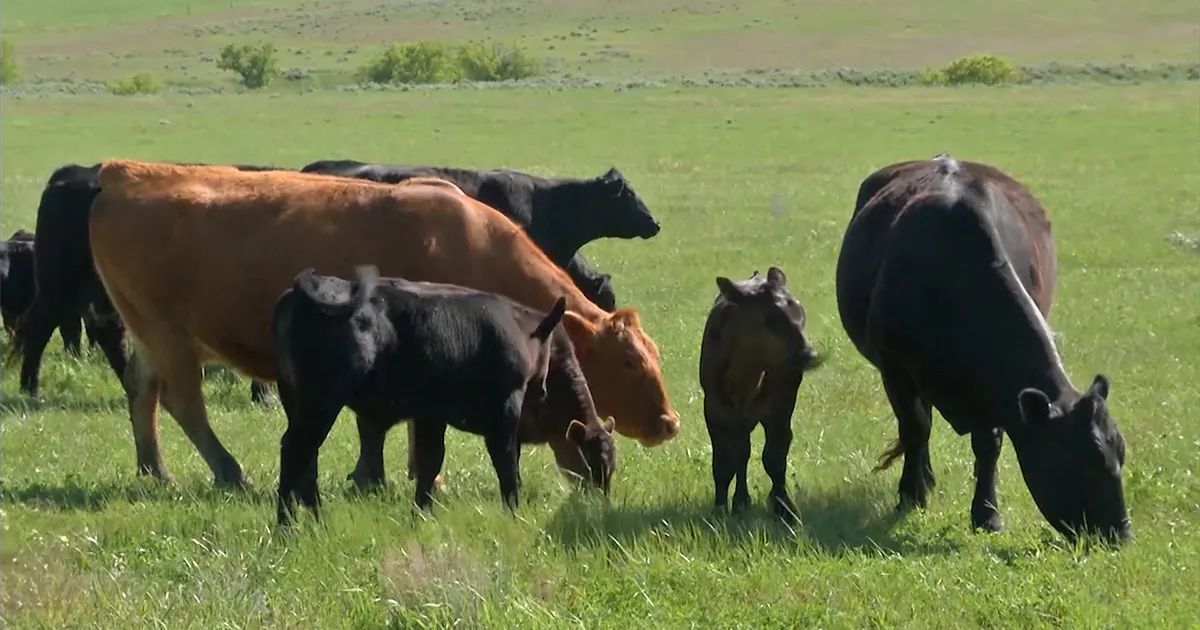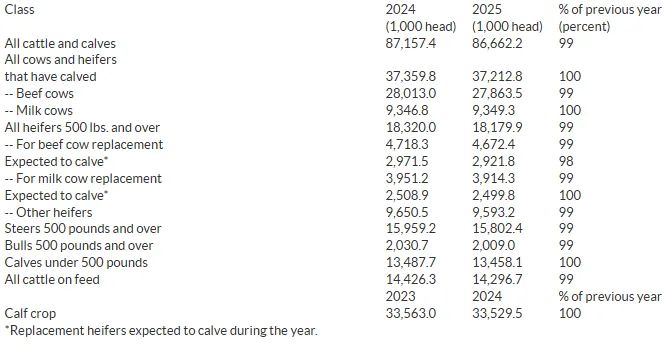
U.S. Cattle Herd Down 1% as of January 1, 2025
January 31, 2025
All cattle and calves in the United States as of Jan. 1, 2025, totaled 86.7 million head, 1% below the 87.2 million head on Jan. 1, 2024, USDA NASS reported on Friday.
All cows and heifers that have calved, at 37.2 million head, were slightly below the 37.4 million head on Jan. 1, 2024. Beef cows, at 27.9 million head, were down 1% from a year ago. Milk cows, at 9.35 million head, were up slightly from the previous year.
All heifers 500 pounds and over as of Jan. 1, 2025, totaled 18.2 million head, 1% below the 18.3 million head on Jan. 1, 2024. Beef replacement heifers, at 4.67 million head, were down 1% from a year ago. Milk replacement heifers, at 3.91 million head, were down 1% from the previous year. Other heifers, at 9.59 million head, were 1% below a year earlier.
Steers weighing 500 pounds and over as of Jan. 1, 2025, totaled 15.8 million head, down 1% from Jan. 1, 2024.
Bulls weighing 500 pounds and over as of Jan. 1, 2025, totaled 2.01 million head, down 1% from Jan. 1, 2024.
Calves under 500 pounds as of Jan. 1, 2025, totaled 13.5 million head, down slightly from Jan. 1, 2024.
Cattle and calves on feed for the slaughter market in the United States for all feedlots totaled 14.3 million head on Jan. 1, 2025. The inventory is down 1% from the Jan. 1, 2024, total of 14.4 million head. Cattle on feed in feedlots with capacity of 1,000 or more head accounted for 82.7% of the total cattle on feed on Jan. 1, 2025, up slightly from the previous year. The combined total of calves under 500 pounds and other heifers and steers over 500 pounds (outside of feedlots), at 24.6 million head, was slightly below Jan. 1, 2024.
CALF CROP DOWN SLIGHTLY
The 2024 calf crop in the United States was estimated at 33.5 million head, down slightly from the previous year's calf crop, according to USDA NASS. Calves born during the first half of 2024 were estimated at 24.6 million head, down slightly from the first half of 2023. Calves born during the second half of 2024 were estimated at 8.93 million head, 27% of the total 2024 calf crop.
REVISIONS
All inventory and calf crop estimates for July 1, 2023, and Jan. 1, 2024, were reviewed using calf crop, official slaughter, import and export data, and the relationship of new survey information to the prior surveys. Based on the findings of this review, July 1, 2023, all cows and heifers that have calved decreased by 0.3% and 2023 calf crop decreased by 0.1%. Jan. 1, 2024, all cows and heifers that have calved decreased by 0.6%.
State-level estimates were reviewed, and changes were made to reallocate inventory estimates to the United States total, according to USDA NASS.

DTN ANALYSIS
"Friday's USDA Cattle inventory report shared exactly what we expected it would: There are fewer beef cows in the U.S. today than there were a year ago, which pushes the U.S. beef cow herd to yet another historic low," DTN Livestock Analyst ShayLe Stewart said following the report's release.
"Of the top 10 beef-producing states in the U.S., the year-over-year changes in each of their individual beef cow inventories varied: Texas up 1%, Oklahoma up 1%, Missouri up 2%, Nebraska down 3%, South Dakota down 3%, Kansas steady, Montana up 1%, Kentucky down 4%, Florida steady and North Dakota up 1%.
"So, while record-high feeder cattle prices were the market's norm through most of 2024, and certainly have been thus far through 2025, cow-calf producers have been reluctant to be overly aggressive about restocking their herds, as the business in which they operate is still laced with plenty of challenges, such as high interest rates, expensive operational costs and the continued concern of drought, all of which can easily erode profitability.
"Needless to say, Friday's report should quiet the murmurs that there has been some slight growth in the cow herd. Not only was the total number of beef cows lower for January 2025 than it was compared to a year ago, but the number of beef replacement heifers was also down 1% compared to a year ago, which indicates that the vast majority of heifer calves are still being marketed as feeder calves as opposed to being kept back as replacement females.
"Come Monday morning, traders should undeniably find Friday's report to be bullish kindling for the cattle complex."
Source: DTN










